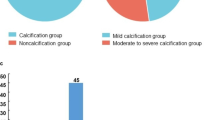Abstract
Assessment of coronary calcium deposits (CCD) by coronary computed tomography (CT) was recently introduced for evaluation of risk to develop events related to coronary heart disease (CHD). We investigated occurrence of CCD in 19 hypopituitary patients (patients), 34 healthy (H) subjects (H controls) and 36 patients with a similar rate of diabetes mellitus and hypertension (morbid, M), but without pituitary diseases (M controls). Patients were replaced with L-thyroxine, cortone acetate, sex hormones and/or desmopressin, but never with GH. Unenhanced coronary CT was performed by 16-row multislice scanner. Framingham score (FS) was calculated and CCD were measured by Agatston score (AS) in all subjects. AS>10 indicates increased CHD risk. CCD and AS >10 were detected in 50% and 33% of patients, respectively. Prevalence of CCD and mean AS were higher in patients than in H and M controls. In patients, AS was negatively dependent on IGF-I levels (p<0.01) and IGF-I SD (p<0.05), and AS >10 was associated with occurrence of hypertension (p<0.02) and hyperinsulinism (p<0.05). Men and women showed the same prevalence of AS >10 (25 vs 31%). FS and AS correlated significantly (rs=0.33, p<0.001), but CCD were detected also in 3/11 patients with low FS. In conclusion, 58% of patients were at CHD risk on the basis of increased FS and/or AS, above all if they were hypertensive and/or showed hyperinsulinism. CCD were detected also in patients with low FS. CHD risk is higher in women. Risk of CCD is increased in patients with low IGF-I levels.
Similar content being viewed by others
References
Leonsson M, Hulthe J, Oscarsson J, et al. Intima-media thickness in cardiovascularly asymptomatic hypopituitary adults with growth hormone deficiency: relation to body mass index, gender, and other cardiovascular risk factors. Clin Endocrinol (Oxf) 2002, 57: 751–9.
Oflaz H, Sen F, Elitok A, et al. Coronary flow reserve is impaired in patients with adult growth hormone (GH) deficiency. Clin Endocrinol (Oxf) 2007, 66: 524–9.
Juul A, Scheike T, Davidsen M, Gyllenborg J, Jørgensen T. Low serum Insulin-Like Growth Factor I is associated with increased risk of ischemic heart disease. A population based case-control study. Circulation 2002, 106: 939–44.
Maison P, Griffin S, Nicoue-Beglah M, Haddad N, Balkau B, Chanson P. Impact of growth hormone (GH) treatment on cardiovascular riskfactors in GH-deficient adults: a metaanalysis of blinded, randomized, placebo-controlled trials. J Clin Endocrinol Metab 2004, 89: 2192–9.
Burger AG, Monson JP, Colao AM, Klibanski A. Cardiovascular risk in patients with growth hormone deficiency: effects of growth hormone substitution. Endocr Pract 2006, 12: 682–9.
Abdul Shakoor SK, Shalet SM. Effects of GH replacement on metabolism and physical performance in GH deficient adults. J Endocrinol Invest 2003, 26: 911–8.
Becker CR, Majeed A, Crispin A, et al. CT measurement of coronary calcium mass: impact on global cardiac risk assessment. Eur Radiol 2005, 15: 96–101.
Budoff MJ, Shaw LJ, Liu ST, et al. Long-term prognosis associated with coronary calcification: observations from a registry of 25, 253 patients. J Am Coll Cardiol 2007, 49: 1860–70.
Cannavò S, Almoto B, Cavalli G, et al. Acromegaly and coronary disease: an integrated evaluation of conventional coronary risk factors and coronary calcifications detected by computed tomography. J Clin Endocrinol Metab 2006, 91: 3766–72.
Pletcher MJ, Tice JA, Pignone M, Browner WS. Using the coronary artery calcium score to predict coronary heart disease events: a systematic review and meta-analysis. Arch Intern Med 2004, 164: 1285–92.
Budoff MJ, Nasir K, McClelland RL, et al. Coronary calcium predicts events better with absolute calcium scores than age-sex-race/ethnicity percentiles: MESA (Multi-Ethnic Study of Atherosclerosis). J Am Coll Cardiol 2009, 53: 345–52.
Tomlinson JW, Holden N, Hills RK, et al. Association between premature mortality and hypopituitarism. Lancet 2001, 357: 425–31.
Conti E, Carrozza C, Capoluongo E, et al. Insulin-like growth factor-1 as a vascular protective factor. Circulation 2004, 110: 2260–5.
Greenland P, Gaziano JM. Clinical practice. Selecting asymptomatic patients for coronary computed tomographic exercise testing. N Engl J Med 2003, 349: 465–73.
Abdu TAM, Neary R, Elhadd TA, Akber M, Clayton RN. Coronary risk in growth hormone deficient hypopituitary adults: increased predicted risk is due largely to lipid profile abnormalities. Clin Endocrinol (Oxf) 2001, 55: 209–16.
Abdu TAM, Elhadd TA, Buch H, Barton D, Neary R, Clayton RN. Recombinant GH replacement in hypopituitary adults improves endothelial cell function and reduces calculated absolute and relative coronary risk. Clin Endocrinol (Oxf) 2004, 61: 387–93.
Greenland P, Bonow RO, Brundage BH, et al. American College of Cardiology Foundation Clinical Expert Consensus Task Force (ACCF/AHA Writing Committee to Update the 2000 Expert Consensus Document on Electron Beam Computed Tomography); Society of Atherosclerosis Imaging and Prevention; Society of Cardiovascular Computed Tomography. ACCF/AHA 2007 clinical expert consensus document on coronary artery calcium scoring by computed tomography in global cardiovascular risk assessment and in evaluation of patients with chest pain. J Am Coll Cardiol 2007, 49: 378–402.
Colao A, Di Somma C, Cuocolo A, et al. Does a gender-related effect of growth hormone (GH) replacement exist on cardiovascular risk factors, cardiac morphology, and performance and atherosclerosis? Results of a two-year open, prospective study in young adult men and women with severe GH deficiency. J Clin Endocrinol Metab 2005, 90: 5146–55.
Centro di Epidemiologia, Sorveglianza e Promozione della Salute — Istituto Superiore di Sanità. La mortalità per causa in Italia: 1980–2002. www.iss.it/site/mortalita.
Author information
Authors and Affiliations
Corresponding author
Rights and permissions
About this article
Cite this article
Cannavò, S., Marini, F., Curtò, L. et al. High prevalence of coronary calcifications and increased risk for coronary heart disease in adults with growth hormone deficiency. J Endocrinol Invest 34, 32–37 (2011). https://doi.org/10.1007/BF03346692
Published:
Issue Date:
DOI: https://doi.org/10.1007/BF03346692



